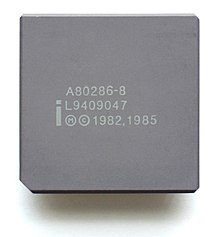
Back إنتل 80286 Arabic 80286 Byelorussian Intel 80286 Catalan Intel 80286 Czech Intel 80286 German Intel 80286 Greek Intel 80286 Spanish 80286 Estonian اینتل ۸۰۲۸۶ Persian Intel 80286 Finnish
 An Intel A80286-8 processor with a gray ceramic heat spreader | |
| General information | |
|---|---|
| Launched | February 1982 |
| Discontinued | 1991[1] |
| Common manufacturer(s) | |
| Performance | |
| Max. CPU clock rate | 4 MHz to 25 MHz |
| FSB speeds | 4 MHz to 25 MHz |
| Data width | 16 bits |
| Address width | 24 bits |
| Architecture and classification | |
| Technology node | 1.5 μm[2] |
| Instruction set | x86-16 (with MMU) |
| Physical specifications | |
| Transistors | |
| Co-processor | Intel 80287 |
| Package(s) | |
| Socket(s) |
|
| History | |
| Predecessor(s) | 8086, 8088 (while 80186 was contemporary) |
| Successor(s) | Intel 80386 |
| Support status | |
| Unsupported | |
The Intel 80286[4] (also marketed as the iAPX 286[5] and often called Intel 286) is a 16-bit microprocessor that was introduced on February 1, 1982. It was the first 8086-based CPU with separate, non-multiplexed address and data buses and also the first with memory management and wide protection abilities. The 80286 used approximately 134,000 transistors in its original nMOS (HMOS) incarnation and, just like the contemporary 80186,[6] it could correctly execute most software written for the earlier Intel 8086 and 8088 processors.[7]
The 80286 was employed for the IBM PC/AT, introduced in 1984, and then widely used in most PC/AT compatible computers until the early 1990s. In 1987, Intel shipped its five-millionth 80286 microprocessor.[8]
- ^ "CPU History - The CPU Museum - Life Cycle of the CPU". cpushack.com. Archived from the original on July 20, 2021. Retrieved September 6, 2021.
- ^ "1.5 μm lithography process - WikiChip". en.wikichip.org. Archived from the original on September 9, 2018. Retrieved January 21, 2019.
- ^ Ormsby, John, "Chip Design: A Race Worth Winning", Intel Corporation, Microcomputer Solutions, July/August 1988, page 18
- ^ "Microprocessor Hall of Fame". Intel. Archived from the original on July 6, 2007. Retrieved August 11, 2007.
- ^ iAPX 286 Programmer's Reference (PDF). Intel. 1983. page 1-1. Archived (PDF) from the original on August 28, 2017. Retrieved August 28, 2017.
- ^ A simpler cousin in the 8086-line with integrated peripherals, intended for embedded systems.
- ^ "Intel Museum – Microprocessor Hall of Fame". Intel.com. May 14, 2009. Archived from the original on March 12, 2009. Retrieved June 20, 2009.
- ^ Teixeira, Kevin, "What's Next For The 80286?", Intel Corporation, Microcomputer Solutions, November/December 1987, page 16
© MMXXIII Rich X Search. We shall prevail. All rights reserved. Rich X Search